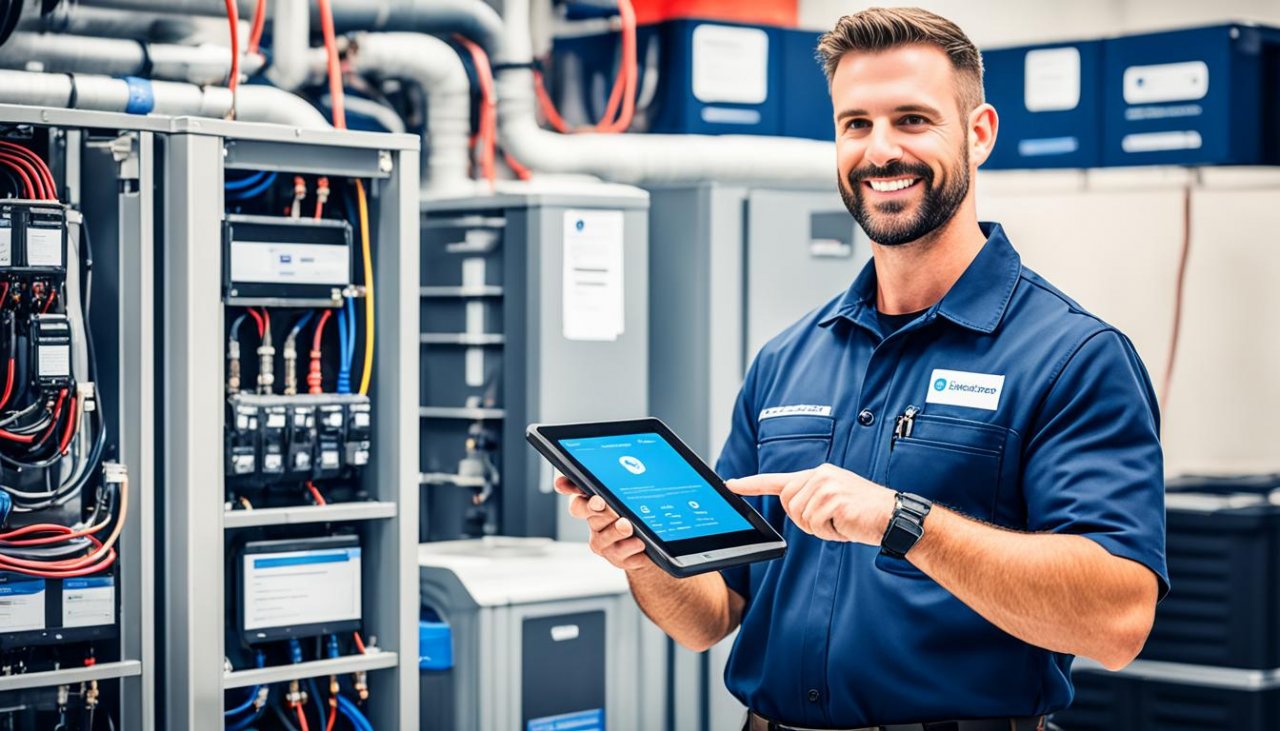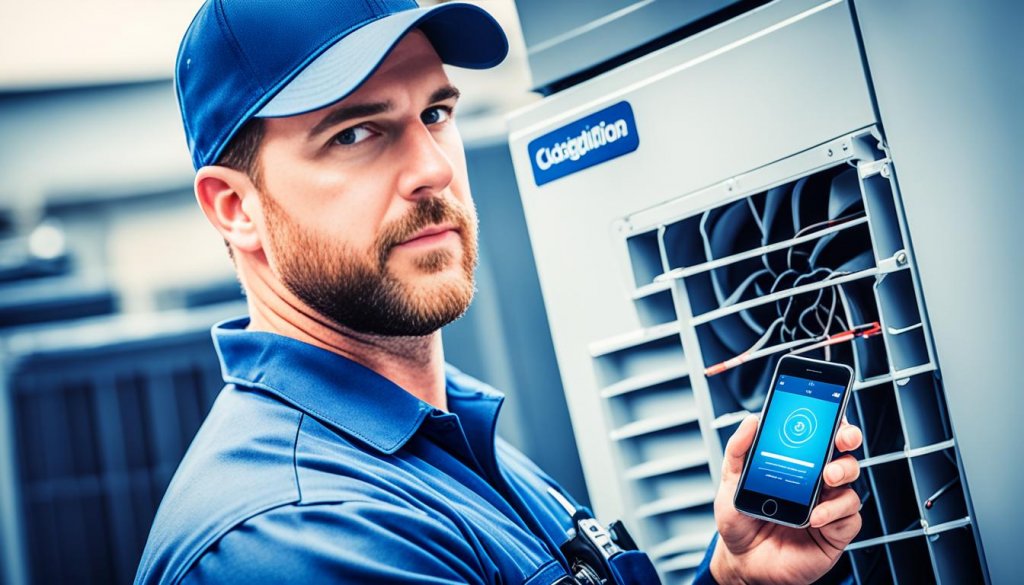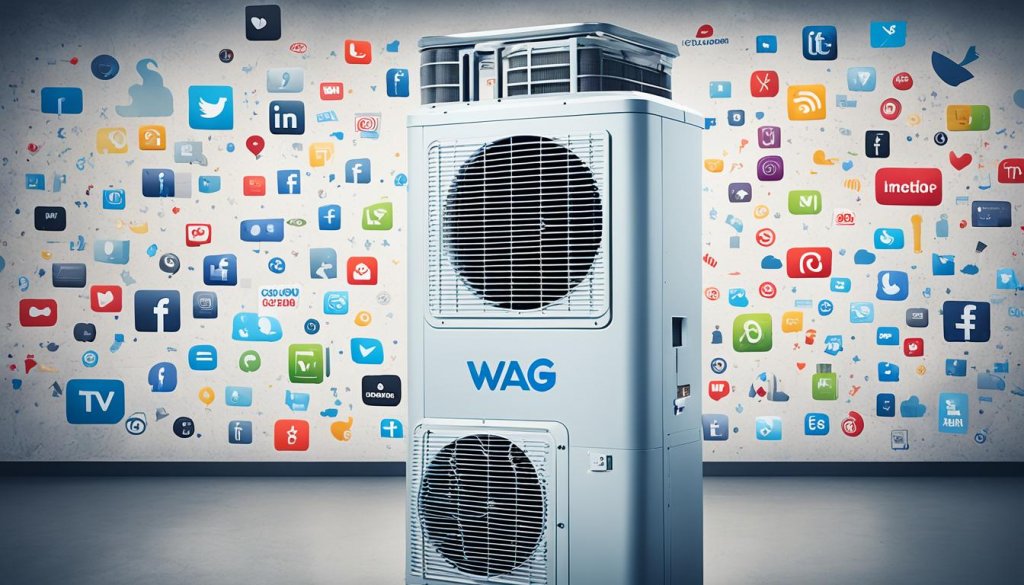Meet Emily. She recently started her own HVAC business, “Cool Comfort Heating and Cooling Services.” As a small business owner, Emily knew that reaching potential customers and establishing her brand’s authority in the competitive HVAC industry would be a challenge.
One day, while scrolling through her social media feed, Emily came across an interesting statistic: in 2022, over 4.59 billion people were using social media worldwide. Intrigued by the immense reach of social media, Emily realized that harnessing its power could significantly benefit her HVAC business.
With social media projected to have nearly 6 billion users by 2027, Emily knew she had to take advantage of this digital marketing platform. After doing some research, she discovered that different social media platforms catered to specific content types and audience preferences.
Emily decided to start with Facebook, a platform with 3.05 billion active monthly users. She knew that creating engaging visuals was essential, so she focused on showcasing stunning photos and videos of her team’s HVAC installations and repairs. By regularly posting content, Emily saw her brand awareness grow, driving more website traffic and generating leads.
Next, Emily turned her attention to Instagram, a platform where visual content is emphasized. She used Instagram to share behind-the-scenes glimpses of her HVAC services, creating a sense of transparency and authenticity. Through Instagram, Emily successfully engaged with her younger audience (18-34 years old), who appreciated her captivating visuals and informative posts.
To establish her authority in the HVAC field, Emily utilized LinkedIn. She shared industry insights, case studies, and success stories, positioning Cool Comfort Heating and Cooling Services as a trusted and knowledgeable name in the industry. By consistently providing valuable content, Emily attracted a loyal following and built a solid reputation on the platform.
Through Twitter, Emily stayed up-to-date with real-time updates, industry news, and quick tips. She also took advantage of Twitter’s targeted PPC ads to reach potential customers in her local area. By strategically using hashtags, Emily joined industry conversations, expanding her content reach and increasing engagement.
Emily recognized the power of video content and turned to YouTube. She created detailed tutorials, provided behind-the-scenes glimpses of her team’s work, and shared customer testimonials. These videos not only showcased the quality of her HVAC services but also helped potential customers feel more confident in choosing her business.
As Emily journeyed through the world of social media marketing, she learned the importance of engagement metrics like likes, shares, and comments. These metrics provided valuable feedback on her social media strategies and allowed her to optimize her content for better results.

Key Takeaways:
- Social media provides a vast audience for HVAC businesses to reach potential customers cost-effectively.
- Facebook, Instagram, LinkedIn, Twitter, and YouTube are key platforms for HVAC businesses to consider, each catering to different content types and audience preferences.
- Clear, SMART goals are recommended for social media marketing campaigns to measure success.
- Visual content and strategic hashtag usage can significantly enhance engagement levels and visibility.
- Utilizing targeted social media ad campaigns can increase brand visibility and conversions.
Pinpointing Your Potential Customers
Before launching your social media marketing campaign, it’s essential to identify your potential customers in the HVAC industry. By understanding your target audience and their demographics, you can create content that caters to their specific needs and preferences.
In the HVAC industry, there are three main customer segments: residential customers, commercial clients, and industrial customers. Residential customers consist of homeowners and tenants looking for HVAC solutions for their homes. Commercial clients include businesses, offices, and retail establishments in need of HVAC services. Industrial customers encompass factories, warehouses, and manufacturing plants that require advanced HVAC systems to optimize energy costs and efficiency.
To effectively reach your potential customers, consider factors such as their age group, income level, and type of residence. By understanding these demographics, you can tailor your marketing efforts and deliver targeted messages that resonate with your audience.
Local SEO strategies are crucial for HVAC businesses to attract potential customers in their local area. Optimizing Google My Business listings and earning local backlinks can help your business rank higher in local search results, making it more visible to customers searching for HVAC services in your area.
By providing excellent customer service, you can enhance your lead generation efforts and build strong customer relationships. Satisfied customers are more likely to refer your services to others and leave positive reviews, which can help attract new potential customers.
Utilizing online platforms like Nextdoor.com and Alignable.com can also boost your online presence and connect you with potential customers in your local area. These platforms allow you to engage with the community, establish trust, and showcase your HVAC expertise.
Remember, pinpointing your potential customers and understanding their demographics is crucial for creating a successful social media marketing campaign. By tailoring your content and targeting the right audience, you can maximize your reach and attract customers who are most likely to benefit from your HVAC solutions.
Choosing the Right Social Media Platforms
Selecting the appropriate social media platforms is essential for reaching your target audience effectively. When it comes to HVAC businesses, leveraging popular social media platforms can significantly contribute to building brand awareness, connecting with customers, and driving business growth. Let’s explore some of the key platforms that HVAC businesses can utilize:
With 78% of Americans having at least one social networking account, Facebook remains a dominant force in social media marketing. It provides a vast user base for HVAC businesses to target and reach potential customers through ads. Utilizing Facebook’s advertising features allows you to precisely segment your audience based on interests like HVAC, AC, and heating. This level of targeting enables you to tailor your content to resonate with your specific industry-related audience.
Moreover, Facebook offers various ad formats, including image ads, video ads, and carousel ads, allowing you to showcase your HVAC services and products creatively. Tracking interactions with your ads becomes seamless with the setup of Facebook Pixel, a crucial step in measuring the effectiveness of your targeted advertising campaigns.
As a visually-driven platform, Instagram is ideal for HVAC businesses to showcase their expertise and craftsmanship through stunning imagery. You can share photos and videos of HVAC installations, before and after transformations, and even behind-the-scenes glimpses of your team at work. By utilizing relevant hashtags and engaging with your audience, you can expand your reach and build a strong brand presence in the HVAC industry.

LinkedIn allows HVAC businesses to position themselves as trusted authorities in the field. By sharing valuable industry insights, thought leadership articles, and educational content, you can establish your expertise and credibility among professionals and potential customers. LinkedIn also provides opportunities for networking, connecting with industry influencers, and even generating leads for commercial HVAC projects.
Twitter’s fast-paced nature makes it suitable for real-time updates and industry news. HVAC businesses can leverage this platform to share timely information about promotions, special offers, and upcoming events. By engaging in conversations and monitoring relevant hashtags, you can stay connected with your audience and position your business as an industry leader.
YouTube
Video content is a powerful tool for HVAC businesses, and YouTube is the ultimate platform for sharing it. You can create informative videos, tutorials, customer testimonials, and even virtual tours of your HVAC projects. By providing valuable content, you can engage your audience, build trust, and establish your HVAC business as a go-to resource in the industry.
Remember, when choosing the right social media platforms for your HVAC business, consider your target audience, the nature of your content, and the unique benefits that each platform offers. By strategically utilizing these social media platforms, you can effectively connect with customers, enhance brand awareness, and drive business success.
Creating Compelling Social Media Content
When it comes to social media marketing for your HVAC business, content is king. Creating compelling social media content is crucial to engage your audience, build trust, and position your brand as an authority in the industry. By offering a variety of content formats, such as HVAC educational content, visual content, interactive content, and seasonal promotions, you can attract and retain followers while driving traffic to your website.
First and foremost, educational content plays a vital role in showcasing your expertise. By creating and sharing informative articles, guides, and videos about HVAC topics, you establish yourself as a trusted source of information. This not only helps your audience learn more about HVAC systems but also positions your business as a reliable authority in the field.
Visual content, including high-quality images and videos, is another powerful way to capture your audience’s attention. Whether it’s showcasing your HVAC installations, before-and-after transformations, or behind-the-scenes glimpses into your team’s work, visual content can help convey the quality of your services and generate interest among prospective customers.
Interactive content is another effective way to engage your audience and encourage them to actively participate. Polls, quizzes, and contests related to HVAC topics can not only provide valuable insights into your customers’ preferences but also foster a sense of community and increase brand awareness.
Lastly, leveraging seasonal promotions can help you tap into current trends and generate excitement among your social media followers. Offering special discounts, limited-time offers, or seasonal maintenance packages can encourage engagement and prompt action from your audience.
Remember, your social media content should aim to provide value to your audience while aligning with your business goals. Take advantage of the effectiveness of high-quality content, and your HVAC business will see increased engagement, brand visibility, and customer trust.
Building a Solid Reputation on Social Media
Building a solid reputation on social media is crucial for the success of your HVAC business. It involves actively engaging with your audience and leveraging the power of customer testimonials and reviews to establish trust and credibility.
To start, make it a priority to respond to comments and messages promptly. This shows that you value your audience’s input and are committed to providing excellent customer service. By addressing their questions and concerns in a timely manner, you can build a reputation as a responsive and reliable HVAC business.
In addition to engagement, encourage satisfied customers to share their experiences on social media. This can be done by requesting them to leave reviews on platforms like Google, Facebook, and Yelp. Positive reviews and testimonials are powerful tools that can attract new customers and help you build a strong reputation in the HVAC industry.
An easy way to encourage customer feedback is by implementing a review request system. After providing exceptional service, send customers a follow-up email thanking them and kindly asking for their feedback. This approach can not only generate positive reviews but also highlight areas for improvement to enhance customer satisfaction.
Remember: 63.6% of customers check reviews before making a purchase, so managing and leveraging happy customers for positive reviews is essential.
Another effective strategy for building a solid reputation is to showcase success stories on social media. Highlight any awards or achievements your HVAC business has earned. Sharing this kind of content can leave a positive impact and demonstrate to potential customers that you are a reputable and trustworthy company.
Make the Most of Testimonials
Testimonials are a powerful way to showcase your HVAC business’s credibility and expertise. When satisfied customers share their experiences, it helps potential customers gain confidence in your services. To maximize the impact of testimonials:
- Feature testimonials prominently on your website and social media platforms.
- Include the customer’s name, photo, and any relevant details to make the testimonials more authentic and relatable.
- Consider creating video testimonials, as they have been shown to be more effective in driving conversions.
By consistently engaging with your audience, leveraging testimonials and reviews, and showcasing your success on social media, you can build a solid reputation for your HVAC business. This reputation will help you stand out in a competitive market and attract more customers who trust in your services and expertise.
Analyzing Social Media Analytics
As an HVAC business, harnessing the power of social media is crucial for success in today’s digital age. However, simply having a presence on platforms like Facebook, Twitter, and LinkedIn is not enough. To truly make the most of your social media efforts, it’s essential to dive deeper and analyze social media analytics.
Social media analytics provide valuable insights into the effectiveness of your social media strategy. By monitoring and analyzing engagement metrics such as likes, shares, and comments, HVAC businesses can gain a better understanding of how their audience is interacting with their content.
Understanding these conversations, their frequency, and sentiment can help you track the impact of your social media presence. By keeping a pulse on the discussions surrounding your company, you can identify areas for improvement, address customer concerns, and seize opportunities to engage with your followers.
Enhancing Your Content Strategy
Analyzing social media analytics can also play a significant role in optimizing your content strategy. By identifying what resonates most with your audience, you can create fresh and interesting content that drives higher engagement.
Regularly posting informative and educational content, such as how-to guides and maintenance tips, can not only attract more followers but also establish your HVAC business as an authority in the industry. It’s worth noting that educational content sees a 50% higher engagement rate on social media compared to promotional content.
Moreover, personalized marketing messages based on data-driven insights can make your content more appealing to your target audience. This approach helps maximize customer conversion rates and ultimately leads to a higher return on investment for your social media campaigns.
Adapting and Improving Marketing Strategies
One of the key benefits of analyzing social media analytics is the ability to adapt and improve your marketing strategies. By tracking and understanding the performance of your social media campaigns, you can identify what works and what doesn’t.
Flexibility in changing marketing campaigns based on these performance results is essential for achieving your business goals. You can allocate your resources more effectively and experiment with different strategies to find the most effective approach for your HVAC business.
Additionally, geofencing marketing combined with other outreach methods can significantly impact customer acquisition. By using hyperlocal targeting, HVAC companies can achieve a 10-25% higher return on investment on their marketing campaigns.
Positioning Your HVAC Business as an Authority
Establishing your HVAC business as an authority in the industry involves providing valuable insights and staying up to date with the latest technologies and practices. As an HVAC authority, I understand the importance of sharing industry news, breakthroughs, and regulations to position your business as a go-to source for HVAC enthusiasts.
By offering expertise on energy-efficient systems, smart home integration, and indoor air quality, I can help your HVAC business demonstrate its knowledge and attract a dedicated following. This not only boosts your credibility but also creates a strong foundation of trust with potential customers.
Leveraging social media platforms such as Facebook, Instagram, and Twitter allows you to share industry insights and establish yourself as a thought leader in the HVAC space. Don’t forget to utilize relevant hashtags, such as #HVACauthority and #latesttechnologies, to join industry conversations and increase the visibility of your content.
Furthermore, optimizing your website for local SEO is crucial to increase visibility among potential customers in your service area. Most customers access HVAC services and read reviews on their smartphones or tablets, so having a mobile-friendly website is paramount.
Additionally, partnering with specialized marketing agencies that understand the industry’s ins and outs can give your HVAC business an edge. These agencies excel in digital marketing tactics, including search engine optimization (SEO), pay-per-click (PPC) advertising, and social media marketing, ensuring your HVAC business gets the attention it deserves.
To solidify your position as an HVAC authority, it’s important to actively manage your online reputation. This includes monitoring online mentions and responding to customer reviews promptly. Satisfied customers are more likely to leave positive reviews, recommend your services to others, and remain loyal to your brand.
Remember, positioning your HVAC business as an authority is an ongoing process that requires continuous monitoring, adjustment, and improvement. But with a strong digital marketing strategy and the expertise of specialized marketing agencies, your HVAC business can make a significant impact in the competitive industry, gaining the trust and loyalty of customers.

The Flexibility and Adaptability of Social Media Marketing
One of the key advantages of social media marketing is its flexibility and adaptability. As an HVAC business, you can quickly adjust your strategies based on real-time social media analytics to effectively reach your target audience. By monitoring engagement metrics like likes, comments, and shares, you can identify underperforming content and make necessary adjustments to improve engagement.
Moreover, actively participating in industry discussions and sharing relevant news and trends helps keep your business relevant and engages your audience. Social media platforms allow you to be agile and responsive, enabling you to stay ahead of the competition and drive growth.
Social media marketing provides the flexibility to experiment with different types of content, such as images, videos, and infographics, to captivate your audience and convey your brand’s message effectively. You can also leverage social media advertising to target specific demographics and reach a broader audience.
Additionally, social media marketing complements other marketing efforts, such as direct mail campaigns. By integrating multi-channel analytics, you can track the impact of both your direct mail and digital marketing campaigns, allowing you to refine your strategies continuously and maximize your results.
Key performance indicators like response rates, conversion rates, cost per acquisition, and customer lifetime value provide valuable insights into the effectiveness of your social media marketing efforts. Through A/B testing of different mail formats and digital ads, you can determine the most successful combinations and optimize your ongoing campaigns.
The HVAC industry experiences demand peaks and valleys due to changing seasons, presenting unique challenges for marketing campaigns. Social media marketing offers the flexibility to adapt quickly to these variations and maintain brand visibility even during off-peak seasons. By strategically investing in marketing during slower periods, you can attract customers and ensure a steady revenue flow.
In conclusion, social media marketing’s flexibility and adaptability empower HVAC businesses to stay connected with their target audience, respond to industry trends in real-time, and achieve their marketing objectives effectively.
Conclusion
In today’s competitive HVAC industry, establishing a strong online presence is essential for business growth and success. By harnessing the power of social media marketing, HVAC businesses can effectively engage their audience, drive more leads, and position themselves as authorities in the field.
To maximize the benefits of social media marketing, it’s crucial to pinpoint your potential customers and choose the right platforms to reach them. Creating compelling content that showcases your expertise and building a solid reputation through excellent customer service are also key. By analyzing social media analytics, you can gain valuable insights to refine your strategies and drive even better results.
Flexibility and adaptability are crucial in the ever-evolving world of social media marketing. Embrace new trends and technologies, and be open to experimentation to stay ahead of the competition.
If you’re looking to elevate your HVAC business’s online presence, consider seeking the expertise of professionals like All Contractor Marketing®. They can help you strategize and optimize your social media marketing efforts, ensuring maximum visibility, engagement, and lead generation.
Remember, a strong online presence is the foundation for success in the digital age. Embrace social media marketing, and watch your HVAC business thrive in the online world.
You may also like:
- Pinpointing Your Potential Customers
- Choosing the Right Social Media Platforms
- Creating Compelling Social Media Content
See how FieldAx can transform your Field Operations.
Try it today! Book Demo
You are one click away from your customized FieldAx Demo!
FAQ
How can social media help my HVAC business?
Social media is a powerful tool for HVAC businesses to showcase their offerings, connect with potential customers, and establish their brand authority.
How do I identify my potential customers for social media marketing?
It’s crucial to identify your potential customers, such as homeowners, property managers, and businesses in need of HVAC solutions. Understand their demographics, behaviors, and specific needs to tailor your content.
What are the best social media platforms for HVAC businesses?
Popular platforms such as Facebook, Instagram, LinkedIn, Twitter, and YouTube offer unique benefits. Facebook allows connection and sharing, Instagram showcases visuals, LinkedIn establishes authority, Twitter provides real-time updates, and YouTube is great for video content.
How can I create compelling social media content for my HVAC business?
Provide educational content, share visuals of work, engage the audience with interactive content, and offer seasonal promotions to leverage trends in the HVAC industry.
How do I build a solid reputation on social media for my HVAC business?
Actively engage with your audience, respond to comments and messages promptly, encourage customers to share photos and leave reviews, and host Q&A sessions or live streams to provide direct engagement.
How can social media analytics help my HVAC business?
Analyzing engagement metrics such as likes, shares, and comments helps understand the audience’s interaction with your content, drive traffic and conversions, and optimize your content strategy.
How can I position my HVAC business as an authority on social media?
Share industry news, breakthroughs, and regulations, offer expertise on energy-efficient systems, smart home integration, and indoor air quality, and utilize relevant hashtags to join industry conversations.
How does social media marketing provide flexibility and adaptability for HVAC businesses?
HVAC businesses can pivot their strategies quickly based on real-time social media analytics, monitor engagement metrics, share and comment on industry news and trends, and stay relevant and engage with their audience.
How can I harness the power of social media for my HVAC business?
By pinpointing your potential customers, choosing the right social media platforms, creating compelling content, building a solid reputation, analyzing social media analytics, positioning yourself as an authority, and embracing the flexibility of social media marketing, you can elevate your online presence, engage your audience, and drive more leads for your HVAC business.
Author Bio
Co-Founder & CMO at Merfantz Technologies Pvt Ltd | Marketing Manager for FieldAx Field Service Software | Salesforce All-Star Ranger and Community Contributor | Salesforce Content Creation for Knowledge Sharing






